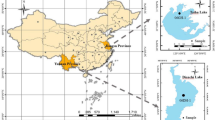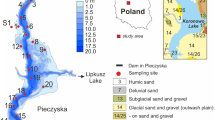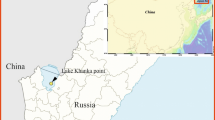Abstract
The main objective of this research was to study the spatial and vertical distribution of 137Cs activity concentrations in the bottom sediments of Turawa Lake 32 years after the Chernobyl fallout to investigate possible factors responsible for the post-fallout migration and accumulation of 137Cs in the selected reservoir. The results demonstrated a strong relationship between the increasing 137Cs and 40K activity concentrations and the decreasing grain size of sediments. Significant amounts of 137Cs were detected in the bottom sediments deposited in the deeper parts of the reservoir (especially near the dam). Therefore, this research showed that Turawa Lake can be an important trap for sediments polluted with 137Cs. Moreover, disturbed vertical distribution of 137Cs activity concentrations in the sediment columns collected from the littoral zone of this lake was observed, which is probably related to the bottom erosion intensified by wind-wave action, bioturbations, and water-level fluctuations. In the profundal zone, the vertical distribution of 137Cs activity concentrations was undisturbed, which indicates stable sedimentation conditions in this part of Turawa Lake.






Similar content being viewed by others
Data availability
The datasets used in the presented study are available from the corresponding author on a reasonable request.
References
R Development Core Team (2012) R: a language and environment for statistical computing. R Foundation for Statistical Computing, Vienna, Austria
Anselmetti FS, Bühler R, Finger D, Girardclos S, Lancini A, Rellstab C, Sturm M (2007) Effects of Alpine hydropower dams on particle transport and lacustrine sedimentation. Aquat Sci 69:179–198
Appleby PG (2005) Chronostratigraphic techniques in recent sediments. In: Tracking Environmental Change Using Lake Sediments. Kluwer Academic Publishers, pp 171–203
Bábek O, Kielar O, Lenďáková Z et al (2020) Reservoir deltas and their role in pollutant distribution in valley-type dam reservoirs: Les Království Dam, Elbe River, Czech Republic. Catena 184:104251. https://doi.org/10.1016/j.catena.2019.104251
Basuki T, Miyashita S, Tsujimoto M, Nakashima S (2018) Deposition density of 134Cs and 137Cs and particle size distribution of soil and sediment profile in Hibara Lake area, Fukushima: an investigation of 134Cs and 137Cs indirect deposition into lake from surrounding area. J Radioanal Nucl Chem 316:1039–1046
Carlsson S (1978) A model for the movement and loss of 137Cs in a small watershed. Health Phys 34:33–37
Cheel RJ (2005) Grain texture. In: Cheel RJ (ed) Introduction to clastic sedimentology. Brock University Middleton, Ontario, pp 8–46
Comans RNJ, Middelburg JJ, Zonderhuis J, Woittiez JRW, De Lange GJ, Lange GJ, Das HA, Van der Weijden CH (1989) Mobilization of radiocaesium in pore water of lake sediments. Nature 339:367–369
Contreras S, Werne JP, Araneda A et al (2018) Organic matter geochemical signatures (TOC, TN, C/N ratio, δ13C and δ15N) of surface sediment from lakes distributed along a climatological gradient on the western side of the southern Andes. Sci Total Environ 630:878–888. https://doi.org/10.1016/J.SCITOTENV.2018.02.225
Diemer J, Allan G, Eckardt I, Kroening D, Vinson D (2011) Sedimentation in a Piedmont reservoir: evidence from Brown’s Cove, Lake Wylie, North Carolina. Environ Eng Geosci 17(2):123–142
Dorr H, Munnich KO (1989) Downward movement of soil organic matter and its influence on trace-element transport (210Pb, 137Cs) in the soil. Radiocarbon 31:655–663. https://doi.org/10.1017/S003382220001225X
Dost RJJ, Mannaerts CMM (2005) Generation of lake bathymetry using SONAR, satellite imagery and GIS. In: ESRI 2008: Proceedings of the 2008 ESRI International User Conference Enschede, The Netherlands
Edgington DN, Val Klump J, Robbins JA, Kusner YS, Pampura VD, Sandimirov IV (1991) Sedimentation rates, residence times and radionuclide inventories in Lake Baikal from 137Cs and 210Pb in sediment cores. Nature 350:601–604
Erlinger C, Lettner H, Hubmer A et al (2008) Determining the Chernobyl impact on sediments of a pre-Alpine lake with a very comprehensive set of data. J Environ Radioact 99:1294–1301. https://doi.org/10.1016/J.JENVRAD.2008.03.012
Evans DW, Alberts JJ, Clark RA (1983) Reversible ion-exchange fixation of cesium-137 leading to mobilization from reservoir sediments. Geochim Cosmochim Acta 47:1041–1049
Eyrolle-Boyer F, Boyer P, Garcia-Sanchez L et al (2016) Behaviour of radiocaesium in coastal rivers of the Fukushima Prefecture (Japan) during conditions of low flow and low turbidity – Insight on the possible role of small particles and detrital organic compounds. J Environ Radioact 151(Pt 1):328–340. https://doi.org/10.1016/J.JENVRAD.2015.10.028
Fujii M, Ono K, Yoshimura C, Miyamoto M (2018) The role of autochthonous organic matter in radioactive cesium accumulation to riverine fine sediments. Water Res 137:18–27. https://doi.org/10.1016/J.WATRES.2018.02.063
Funaki H, Yoshimura K, Sakuma K, Iri S, Oda Y (2019) Evaluation of particulate 137Cs discharge from a mountainous forested catchment using reservoir sediments and sinking particles. J Environ Radioact 210:105814
Gąsiorowski M (2008) Deposition rate of lake sediments under different alternative stable states. Geochronometria 32:29–35
Gąsiorowski M, Hercman H (2005) Recent changes of sedimentation rate in three Vistula oxbow lakes determined by 210Pb dating. Geochronometria 24:33–39
Golosov VN, Ivanov MM, Tsyplenkov AS et al (2021) Erosion as a factor of transformation of soil radioactive contamination in the basin of the Shchekino Reservoir (Tula Region). Eurasian Soil Sci 54:291–303. https://doi.org/10.1134/S106422932102006X
Gurwin J (2010) Groundwater hazard regarding environmental impact assessment of renaturalisation of the Turawa reservoir (in Polish). Biul Państw Inst Geol 440:65–76
Gurwin J, Kryza H, Kryza J, Poprawski L (2005) Groundwater recognizing in the region of Turawa Lake for needs of ecological state assessment (in Polish). Współczesne Probl Hydrogeol 12:241–253
Hammer Ø, Harper DAT, Ryan PD (2001) PAST: paleontological statistics software package for education and data analysis. Palaeontol Electron 4:9
He Q, Walling DE (1996) Interpreting particle size effects in the adsorption of 137Cs and unsupported 210Pb by mineral soils and sediments. J Environ Radioact 30(2):117–137
Hilton J, Lishman JP, Allen PV (1986) The dominant processes of sediment distribution and focusing in a small, eutrophic, monomictic lake. Limnol Oceanogr 31(1):125–133
Huon S, Hayashi S, Laceby JP, Tsuji H, Onda Y, Evrard O (2018) Source dynamics of radiocesium-contaminated particulate matter deposited in an agricultural water reservoir after the Fukushima nuclear accident. Sci Total Environ 612:1079–1090
Ilus E, Saxen R (2005) Accumulation of Chernobyl-derived 137Cs in bottom sediments of some Finnish lakes. J Environ Radioact 82:199–221
Ivanov MM et al (2021) Using reservoir sediment deposits to determine the longer-term fate of chernobyl-derived 137Cs fallout in the fluvial system. Environ Pollut 274:116588
Jagielak J, Biernacka M, Henschke J, Sosińska A (1998) Radiological Atlas of Poland (in Polish). Biblioteka Monitoringu Środowiska PIOŚ, Warsaw
Kaminski S, Richter T, Walser M, Lindner G (1994) Redissolution of cesium radionuclides from sediments of freshwater lakes due to biological degradation of organic matter. Radiochim Acta 66(67):433–436
Kansanen PH, Jaakkola T, Kulmala S, Suutarinen R (1991) Sedimentation and distribution of gamma emitting radionuclides in bottom sediments of southern Lake Piijanne, Finland, after the Chernobyl accident. Hydrobiologia 222:121–140
Kapała J, Karpińska M, Mnich Z, Szpak A, Milewski R, Citko D (2008) The changes in the contents of 137Cs in bottom sediments of some Masurian lakes during 10–15 y observation (Poland). Radiat Prot Dosimetry 130(2):178–185
Klaminder J, Appleby P, Crook P, Renberg I (2012) Post-deposition diffusion of 137Cs in lake sediment: Implications for radiocaesium dating. Sedimentology 59(7):2259–2267
Koarashi J, Nishimura S, Nakanishi T et al (2016) Post-deposition early-phase migration and retention behavior of radiocesium in a litter–mineral soil system in a Japanese deciduous forest affected by the Fukushima nuclear accident. Chemosphere 165:335–341. https://doi.org/10.1016/J.CHEMOSPHERE.2016.09.043
Konoplev et al (2018) Natural attenuation of Fukushima-derived radiocesium in soils due to its vertical and lateral migration. J Environ Radioact 186:23–33
Laceby JP, Huon S, Onda Y et al (2016) Do forests represent a long-term source of contaminated particulate matter in the Fukushima Prefecture? https://doi.org/10.1016/j.jenvman.2016.09.020
Lan J, Wang T, Chawchai S, Cheng P, Zhou K, Yu K, Yan D, Wang Y, Zang J, Liu Y, Tan L, Ai L, Xu H (2020) Time marker of 137Cs fallout maximum in lake sediments of Northwest China. Quatern Sci Rev 241:106413
Latala A, Wierzba S (2007) Biodegradation of bottom sediments of Turawa Lake. Pol J Chem Technol 9(2):73–77
Machowski R, Ruman M, Rzętała MA, Rzętała M (2008) Morphology of the bottom and the littoral zone of Turawa reservoir (in Polish). Kształtowanie środowiska geograficznego i ochrona przyrody na obszarach uprzemysłowionych i zurbanizowanych 39:45–55
Madruga MJ, Silva L, Gomes AR et al (2014) The influence of particle size on radionuclide activity concentrations in Tejo River sediments. J Environ Radioact 132:65–72. https://doi.org/10.1016/J.JENVRAD.2014.01.019
Majerová L, Bábek O, Navrátil T et al (2018) Dam reservoirs as an efficient trap for historical pollution: the passage of Hg and Pb through the Ohře River, Czech Republic. Environ Earth Sci 77. https://doi.org/10.1007/s12665-018-7761-3
Mclean RI, Summers JK, Mclean RL (1990) Evaluation of transport and storage of 6°Co, 134Cs, 137Cs and 65Zn by river sediments in the lower Susquehanna River. Environ Pollut 63:137–153
Meyers PA, Ishiwatari R (1995) Organic matter accumulation records in lake sediments. In: Lerman A, Imboden DM, Gat JR (eds) Physics and Chemistry of Lakes. Springer, Berlin, pp 279–328
Mietelski JW, Dubchak S, Błażej S, Anielska T, Turnau K (2010) 137Cs and 40K in fruiting bodies of different fungal species collected in a single forest in southern Poland. J Environ Radioact 101(9):706–711
Mishra S, Sahoo SK, Bossew P et al (2016) Vertical migration of radio-caesium derived from the Fukushima Dai-ichi Nuclear Power Plant accident in undisturbed soils of grassland and forest. J Geochem Explor 169:163–186. https://doi.org/10.1016/J.GEXPLO.2016.07.023
Muñoz-Salinas E, Castillo M, Romero F, Correa-Metrio A (2021) Understanding sedimentation at the El Molinito reservoir (NW Mexico) before and after dam construction using physical sediment analyses. J S Am Earth Sci 111:103401
Natkaniec J (1999) Accumulation of anthropogenic radioactive elements in soils near Nysa and Opole and sediments of Turawa reservoir (in Polish). Zesz Nauk AR Krak Inż Środ 19(355):57–70
Naulier M, Eyrolle-Boyer F, Boyer P et al (2017) Particulate organic matter in rivers of Fukushima: an unexpected carrier phase for radiocesiums. Sci Total Environ 579:1560–1571. https://doi.org/10.1016/J.SCITOTENV.2016.11.165
Park CW, Kim SM, Kim I et al (2021) Sorption behavior of cesium on silt and clay soil fractions. J Environ Radioact 233:106592. https://doi.org/10.1016/J.JENVRAD.2021.106592
Pulley S, Foster IDL, Collins AL, Zhang Y, Evans J (2018) An analysis of potential controls on long-term 137Cs accumulation in the sediments of UK lakes. J Paleolimnol 60:1–30
Putyrskaya V, Klemt E, Röllin S, Corcho-Alvarado JA, Sahli H (2020) Dating of recent sediments from Lago Maggiore and Lago di Lugano (Switzerland/Italy) using 137Cs and 210Pb. J Environ Radioact 212:106135
Ries T, Putyrskaya V, Klemt E (2019) Long-term distribution and migration of 137Cs in a small lake ecosystem with organic-rich catchment: a case study of Lake Vorsee (Southern Germany). J Environ Radioact 198:89–103
Rigol A, Vidal M, Rauret G (2002) An overview of the effect of organic matter on soil-radiocaesium interaction: implications in root uptake. J Environ Radioact 58:191–216. https://doi.org/10.1016/S0265-931X(01)00066-2
Sakuma K, Malins A, Funaki H, Kurikami H, Niizato T, Nakanishi T, Mori K, Tada K, Kobayashi T, Kitamura A, Hosomi M (2018) Evaluation of sediment and 137Cs redistribution in the Oginosawa River catchment near the Fukushima Dai-ichi Nuclear Power Plant using integrated watershed modeling. J Environ Radioact 182:44–51
Santschi PH, Bollhalder S, Zingg S, Lueck A, Farrenkothen K (1990) The self-cleaning capacity of surface waters after radioactive fallout evidence from European waters after Chernobyl, 1986–1988. Environ Sci Technol 24(4):519–527
Santschi PH, Nyffeler UP, Anderson RF, Schiff SL, O’Hara P, Hesslein RH (1986) Response of radioactive trace metals to acid-base titrations in controlled experimental ecosystems: evaluation of transport parameters for application to whole-lake radiotracer experiments. Can J Fish Aquat Sci 43:60–77
Sedláček J, Bábek O, Kielar O (2016) Sediment accumulation rates and high-resolution stratigraphy of recent fluvial suspension deposits in various fluvial settings, Morava River catchment area, Czech Republic. Geomorphology 254:73–87
Smith JT, Beresford NA (2005) Chernobyl – catastrophe and consequences. Springer
Somboon S, Kavasi N, Sahoo SK et al (2018) Radiocesium and 40K distribution of river sediments and floodplain deposits in the Fukushima exclusion zone. J Environ Radioact 195:40–53. https://doi.org/10.1016/j.jenvrad.2018.09.003
Strzelecki R, Wołkowicz S, Szewczyk J, Lewandowski P (1993) Map of cesium concentration in Poland, radiological map of Poland (I) (in Polish). Polish Geological Institute, Warsaw
Szarłowicz K, Reczyński W, Gołaś J, Kościelniak P, Skiba M, Kubica B (2011) Sorption of 137Cs and 210Pb on sediment samples from a drinking water reservoir. Pol J Environ Stud 20(5):1305–1312
Tachi Y, Sato T, Takeda C et al (2020) Key factors controlling radiocesium sorption and fixation in river sediments around the Fukushima Daiichi Nuclear Power Plant. Part 2: Sorption and fixation behaviors and their relationship to sediment properties. Sci Total Environ 724:138097. https://doi.org/10.1016/J.SCITOTENV.2020.138097
Teisseyre AK (1983) Bottoms of Turawa Lake in the light of geological research (in Polish). Geol Sudet 18(1):21–60
Tsabaris C, Eleftheriou G, Kapsimalis V et al (2007) Radioactivity levels of recent sediments in the Butrint Lagoon and the adjacent coast of Albania. Appl Radiat Isot 65:445–453. https://doi.org/10.1016/J.APRADISO.2006.11.006
Tsuji H, Tanaka A, Komatsu K, Kohzu A, Matsuzaki SS, Hayashi S (2019) Vertical/spatial movement and accumulation of 137Cs in a shallow lake in the initial phase after the Fukushima Daiichi nuclear power plant accident. Appl Radiat Isot 147:59–69
Wakiyama Y, Onda Y, Yoshimura K et al (2019) Land use types control solid wash-off rate and entrainment coefficient of Fukushima-derived 137Cs, and their time dependence. J Environ Radioact 210:105990. https://doi.org/10.1016/J.JENVRAD.2019.105990
Wang Q, Sha Z, Wang J, Zhong Q, Fang P, Ma Y, Du J (2020) Vertical distribution of radionuclides in Lake Qinghai, Qinghai-Tibet Plateau, and its environmental implications. Chemosphere 259(8):127489
Wojewoda J (2013) The sand spit in Turawa Lake - sedimentological study (in Polish). Conference abstract, POKOS 5’2013, 90–92
Wołkowicz S, Strzelecki R (2002) Geochemistry of post-Chernobyl cesium in soils and plants in Opole region (in Polish). Przegl Geol 50(10):941–944
Wróbel Ł, Dołhańczuk-Śródka A, Kłos A, Ziembik Z (2015) The activity concentration of post-Chernobyl 137Cs in the area of the Opole Anomaly (southern Poland). Environ Monit Assess 187(1):4084
Yoshimura K, Onda Y, Fukushima T (2014) Sediment particle size and initial radiocesium accumulation in ponds following the Fukushima DNPP accident. Sci Rep 4(4514):1–6
Zapata F, Nguyen ML (2010) Soil erosion and sedimentation studies using environmental radionuclides. Radioact Environ 16:295–322
Ziembik Z, Dołhańczuk-Śródka A, Komosa A, Orzeł J, Wacławek M (2010) Assessment of 137Cs and 239, 240Pu distribution in forest soils of the Opole anomaly. Water Air Soil Pollut 206(1):307–320
Acknowledgements
We would like to thank Elwira Sienkiewicz, Wojciech Sienkiewicz, and Anna Mulczyk from the Institute of Geological Sciences of the Polish Academy of Sciences for their help during field and laboratory work. We would like also to thank Šárka Matoušková from the Institute of Geology of the Czech Academy of Sciences for her help during field work. We also thank the reviewers for their useful comments and helpful suggestions.
Funding
This work was supported by the internal project ‘Turawa’ by the Institute of Geological Sciences of the Polish Academy of Sciences.
Author information
Authors and Affiliations
Contributions
IS contributed to the study conception, sample collection, material preparation, analyses, writing the manuscript, and revision. MG was responsible for the conceptualization, sample collection, supervising the analyses, and manuscript editing.
Corresponding author
Ethics declarations
Ethics approval and consent to participate
Not applicable.
Consent for publication
Not applicable.
Conflict of interest
The authors declare no competing interests.
Additional information
Responsible Editor: Georg Steinhauser
Publisher's Note
Springer Nature remains neutral with regard to jurisdictional claims in published maps and institutional affiliations.
Rights and permissions
About this article
Cite this article
Sekudewicz, I., Gąsiorowski, M. Spatial and vertical distribution of 137Cs activity concentrations in lake sediments of Turawa Lake (Poland). Environ Sci Pollut Res 29, 80882–80896 (2022). https://doi.org/10.1007/s11356-022-21417-1
Received:
Accepted:
Published:
Issue Date:
DOI: https://doi.org/10.1007/s11356-022-21417-1




